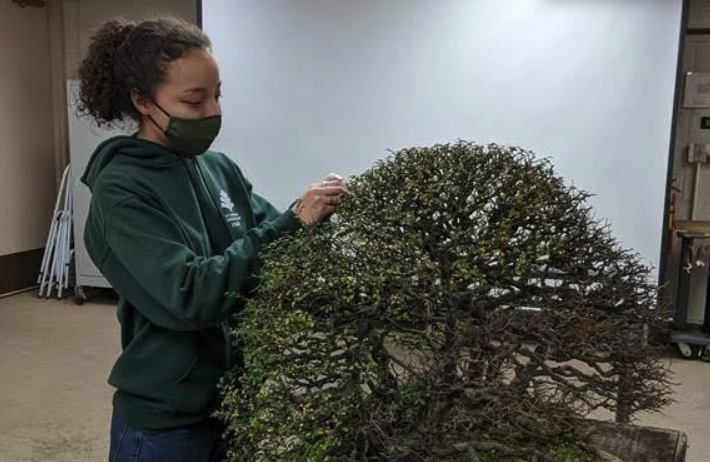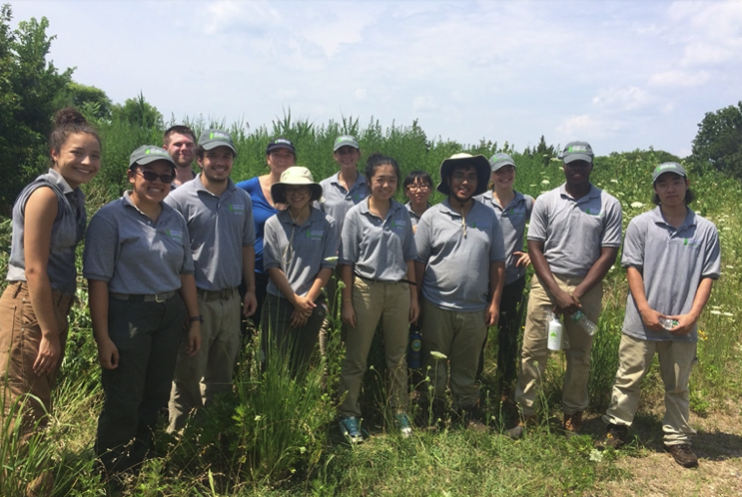Isiah White, 2024 National Bonsai Apprentice
We are pleased to introduce the 2024 National Bonsai Apprentice, Isiah White! He joins us as we send our best wishes to the 2023 Apprentice, Angelica Ramirez, who is now serving as the Bonsai Assistant at the Chicago Botanic Gardens.
Isiah comes to the National Bonsai and Penjing Museum after four years of learning at Superfly Bonsai, a local bonsai supplier in Pennsylvania. Unfortunately, the business had to close, but there was a silver lining: Isiah had the opportunity to apply for the nation’s premiere bonsai apprenticeship, which is funded by the National Bonsai Foundation.
The purpose of the National Bonsai Apprenticeship is to train a new generation of American bonsai artists to ensure the future of the art of bonsai. Each Apprentice in the renowned program receives immersive education with expert curators and caretakers, hands-on experience with America’s national bonsai and penjing collections, and daily opportunities to hone horticultural and artistic talents.
Isiah brings five years of experience to the role. He has grown and maintained a wide variety of live tree stock, managed collections and nurseries, and nurtured hundreds of specimens professionally and personally. “The feeling of seeing plants successfully grow brings me a lot of excitement and joy,” he said.
Studying with renowned bonsai artists has helped to further hone his craft. He has learned from experts such as Chuck Harris, Chase Rosade, and Hugo Zamora. Every artist has a unique approach to this fascinating medium, and which has influenced his philosophy and deepened his understanding of the art form.
Isiah’s bonsai journey began in earnest in 2017, but his interest in art started much earlier.
“I grew up as an artist,” he said. “I was drawing flowers before I knew how to speak properly.” He struggled with learning early in life, but found a creative outlet at the age of 5 when his father gave him his first art set. He continued to draw throughout his school years and attended the Capital Area School of the Arts in Harrisburg, Pennsylvania. He went on to study biology at Harrisburg Area Community College. His artistic and natural pursuits continue to this day, and they also influence his approach to bonsai.
He discovered his love for plant cultivation after serving in the Army National Guard. During ten years in the military, he dabbled in horticulture as a way to combat depression. When he was discharged, he began to dedicate increasingly more time to his new hobby. He started small, buying a few plants from a home improvement store – and was immediately hooked. After tending to them for several days, he doubled the size of his budding collection, eager to learn how to care for as many new varieties as possible.
“I would sit and study each and every plant.
I would take notes, and spend hours reading and watching videos on the anatomy of plants.”
Over the next two years, he taught himself how to nurture them and keep them thriving. “I would sit and study each and every plant,” he said. “I would take notes, and spend hours reading and watching videos on the anatomy of plants to find out what they like and don’t like, what different colorations meant, and how to treat and prevent ailments.”
Isiah, like many people who grew up in the 1980s and 90s, was first introduced to bonsai through the character Mr. Miyagi in the popular film The Karate Kid. Although he was at first intimidated by the art form, he was intrigued by the challenge of learning it. Realizing that he wanted to be around plant life at all times, Isiah began to pursue a professional career as a nursery manager.
At Superfly Bonsai, he started from the ground up, literally: He began in the soil section of the warehouse, learning about different types of fertilizers, nutrients, and the specific benefits to bonsai trees. Over the next few years, Isiah immersed himself in every aspect of the art, increasing his understanding of tools, pots, and soil, and learning to grow trees from seedlings to live stock to cultivated specimens. He helped to tray thousands of seeds and developed the fledgling nursery into a full-grown bonsai farm.
When the business closed, Isiah was thirsty for more knowledge. He was led to the National Bonsai Apprenticeship by his passion for bonsai and his dedication to digging ever deeper into the art form. Serving alongside the expert curators at the National Bonsai and Penjing Museum is the ideal way to continue to develop his skills and expertise. It also gives him a meaningful way to overcome depression, find clarity and balance, and focus on his lifelong ambition.
“Bonsai reminds me
of who I am.”
“Bonsai reminds me of who I am,” he said. “It has done so much for me over the last five years, and I am starting to devote my life to the art of bonsai. I am so thankful to the National Bonsai Foundation for making this role possible, and I’m excited to learn from the incredible curators at the National Bonsai and Penjing Museum.”
As the National Bonsai Apprentice, Isiah will continue his journey of self-discovery and will hone his vision for a life of bonsai caretaking. Aside from tending to his personal collection of hundreds of trees, he wants to start a bonsai farm, build a school for bonsai, and create space for people to pause and find themselves through the art form.
Welcome, Isiah! We are thrilled to have you on the team and look forward to all that you will do for the Museum, the art of bonsai, and our community.
NBF is pleased to provide complete financial support for this Apprenticeship, thanks to our generous donors. Without your help, this premiere national apprenticeship that helps to usher in the next generation of horticulturists wouldn’t be possible. Make a tax-deductible gift today to support the future of bonsai artistry.





















